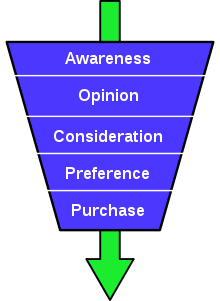Purchase funnel

The purchase funnel, or purchasing funnel, is a consumer focused marketing model which illustrates the theoretical customer journey towards the purchase of a product or service.
In 1898, E. St. Elmo Lewis developed a model which mapped a theoretical customer journey from the moment a brand or product attracted consumer attention to the point of action or purchase.[1] St. Elmo Lewis’ idea is often referred to as the AIDA-model - an acronym which stands for Awareness, Interest, Desire, and Action. This staged process is summarized below:
- Awareness – the customer is aware of the existence of a product or service
- Interest – actively expressing an interest in a product group
- Desire – aspiring to a particular brand or product
- Action – taking the next step towards purchasing the chosen product
This early model has been evolved by marketing consultants and academics to cater for the modern customer and is now referred to in marketing as the purchase funnel. Many different consumer purchase models exist in marketing today, but it is generally accepted that the modern purchase funnel has more stages,[2] considers repurchase intent and takes into account new technologies and changes in consumer purchase behaviour.[3]
The Purchase Funnel is also often referred to as the “customer funnel,” “marketing funnel,” or “sales funnel.” The concept of associating the funnel model with the AIDA concept was first proposed in Bond Salesmanship by William W. Townsend in 1924.[4]
The purchase funnel concept is used in marketing to guide promotional campaigns targeting different stages of the customer journey, and also as a basis for customer relationship management (CRM) programmes and lead management campaigns.
Conversion Funnel
Similar to a purchase funnel, 'conversion funnel' is a technical term used in e-commerce operations to describe the track a consumer takes through an Internet advertising or search system, navigating an e-commerce website and finally converting to a sale.
See also
- DAGMAR marketing
- Sales Process
- Customer Relationship Management
- Customer Lifecycle Management
References
- ↑ Barry, Thomas. 1987. The Development of the Hierarchy of Effects: An Historical Perspective. Current Issues and Research in Advertising, 251-295.
- ↑ A modern purchase funnel concept - Marketing-made-simple.com (2009)
- ↑ The customer decision journey - McKinsey Quarterly(2009)
- ↑ "The salesman should visualize his whole problem of developing the sales steps as the forcing by compression of a broad and general concept of facts through a funnel which produces the specific and favorable consideration of one fact. The process is continually from the general to the specific, and the visualizing of the funnel has helped many salesmen to lead a costumer from Attention to Interest, and beyond" (p. 109).